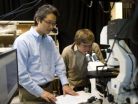(Press-News.org) The presence of antinuclear antibodies (ANA) indicates the possibility of autoimmunity and the indirect immunofluorescence (IIF) assay on HEp-2 cells is the standard blood test (ANA-HEp-2) used to detect ANA. However, studies have shown that a "false-positive" ANA test occurs in up to 13% of healthy individuals. In such cases the test detects the presence of autoantibodies that apparently are not associated with autoimmunity. Researchers from Brazil have now uncovered distinguishing characteristics of the ANA test in healthy individuals and patients with autoimmune disease, reducing the likelihood of an erroneous autoimmune disorder diagnosis. Their findings are published in the January 2011 issue of Arthritis & Rheumatism, a journal of the American College of Rheumatology (ACR).
The immune system is responsible for protecting the body against foreign invaders and infection, but in some individuals the immune system repeatedly attacks healthy cells in the body resulting in an autoimmune disease. According to the Centers for Disease Control and Prevention (CDC) autoimmune diseases—which include rheumatoid arthritis, Sjögren's syndrome, and systemic lupus erythematosus—affect up to 8% (22 million individuals) of the U.S. population.
The Brazilian research team, led by Luis Andrade, MD, PhD, from the Federal University of São Paulo, recruited 918 healthy individuals (634 females and 284 males) between the ages of 18 and 66 years for this study. In the control group were 153 patients with autoimmune rheumatic diseases that included lupus (87), systemic sclerosis (45), Sjögren's syndrome (11) and idiopathic inflammatory myopathy (10). To determine the concentration of ANA in the blood, ANA-HEp-2 tests were run on all participants and considered positive if a well defined IIF pattern was identified.
"The ANA-HEp-2 test is positive in a sizable portion of the general population and our findings established distinguishing characteristics between healthy individuals and patients with autoimmune disease which is essential to accurately interpret the test results," explained Dr. Andrade. Researchers determined that positive ANA-HEp-2 tests in healthy participants occurred predominantly as a nuclear fine speckled (NFS) pattern (at low to moderate titer) or as a nuclear dense fine speckled (NDFS) pattern (frequently at high titer) in 46% and 33% of ANA-positive healthy individuals, respectively. Healthy participants did not present a nuclear coarse speckled (NCS) or a nuclear homogeneous (Ho) pattern.
In those with autoimmune disease the ANA-HEp-2 showed positive results at a predominantly moderate to high titer. A distinct ANA-HEp-2 pattern profile was observed, characterized by the absence of the NDFS pattern and the exclusive occurrence of the NCS (26%), centromeric (8%), nuclear homogeneous (7%), and cytoplasmic dense fine speckled (3%) patterns. ANA-positive patients with confirmed autoimmune diseases also showed the presence of the NFS (42%), but at a higher titer than in healthy individuals.
At the end of a 4-year follow-up period 73% of the ANA-positive healthy individuals retained a positive test result, but did not develop any symptoms of autoimmune rheumatic disease. "Our study confirms that the ANA-HEp-2 pattern is critical in properly diagnosing autoimmune disorders and future research should attempt to reproduce the interpretation of test results among different ANA experts and ANA-HEp-2 slides brands," Dr. Andrade concluded.
INFORMATION:
Article: "ANA HEp-2 Pattern Is A Critical Parameter For Discriminating ANA-Positive Healthy Individuals And Patients With Autoimmune Rheumatic Diseases." Henrique A Mariz, Emília I Sato, Silvia H Barbosa, Silvia H Rodrigues, Alessandra Dellavance, Luis E Andrade. Arthritis & Rheumatism; Published Online: December 28, 2010 (DOI: 10.1002/art.30084); Print Issue Date: January 2011. http://onlinelibrary.wiley.com/doi/10.1002/art.30084/abstract.
This study is published in Arthritis & Rheumatism. Media wishing to receive a PDF of the article may contact healthnews@wiley.com.
About the Journal
Arthritis & Rheumatism is an official journal of the American College of Rheumatology (ACR) and the Association of Rheumatology Health Professionals (ARHP), a division of the College, and covers all aspects of inflammatory disease. The American College of Rheumatology (www.rheumatology.org) is the professional organization who share a dedication to healing, preventing disability, and curing the more than 100 types of arthritis and related disabling and sometimes fatal disorders of the joints, muscles, and bones. Members include practicing physicians, research scientists, nurses, physical and occupational therapists, psychologists, and social workers. For details, please visit http://onlinelibrary.wiley.com/journal/10.1002/(ISSN)1529-0131.
About Wiley-Blackwell
Wiley-Blackwell is the international scientific, technical, medical, and scholarly publishing business of John Wiley & Sons, with strengths in every major academic and professional field and partnerships with many of the world's leading societies. Wiley-Blackwell publishes nearly 1,500 peer-reviewed journals and 1,500+ new books annually in print and online, as well as databases, major reference works and laboratory protocols. For more information, please visit www.wileyblackwell.com or our new online platform, Wiley Online Library (wileyonlinelibrary.com), one of the world's most extensive multidisciplinary collections of online resources, covering life, health, social and physical sciences, and humanities.
END
During a total eclipse of the Sun, skywatchers are awed by the shimmering corona -- a faint glow that surrounds the Sun like gossamer flower petals. This outer layer of the Sun's atmosphere is, paradoxically, hotter than the Sun's surface, but so tenuous that its light is overwhelmed by the much brighter solar disk. The corona becomes visible only when the Sun is blocked, which happens for just a few minutes during an eclipse.
Now, an instrument on board NASA's Solar Dynamics Observatory (SDO), developed by Smithsonian scientists, is giving unprecedented views of the ...
New research found clinicians who care for patients with osteoarthritis (OA) are likely not following standard care guidelines that are based on current medical evidence. Researchers noted physicians were prescribing medications for pain and inflammation, or opting for surgical interventions rather than recommending weight loss plans or exercise programs to OA patients. Details of the this study are available in the January 2011 issue of Arthritis Care & Research, a journal published by Wiley-Blackwell on behalf of the American College of Rheumatology.
A 2002 report ...
WEST LAFAYETTE, Ind. - Researchers are creating a new type of solar cell designed to self-repair like natural photosynthetic systems in plants by using carbon nanotubes and DNA, an approach aimed at increasing service life and reducing cost.
"We've created artificial photosystems using optical nanomaterials to harvest solar energy that is converted to electrical power," said Jong Hyun Choi, an assistant professor of mechanical engineering at Purdue University.
The design exploits the unusual electrical properties of structures called single-wall carbon nanotubes, using ...
More plant matter could be burned in coal-fired power stations if this 'green' fuel was delivered pre-roasted like coffee beans, according to researchers from the University of Leeds, UK.
Many UK power stations are now burning plant matter, or biomass, as well as coal in a bid to cut their carbon footprint. Unlike fossil fuels, plants like willow, Miscanthus and poplar are a virtually carbon-neutral source of energy: the carbon dioxide emitted when they burn is absorbed during photosynthesis by the next batch of 'energy crops' planted in their place.
But the environmental ...
WEST LAFAYETTE, Ind. - The United States doesn't have the infrastructure to meet the federal mandate for renewable fuel use with ethanol but could meet the standard with significant increases in cellulosic and next-generation biofuels, according to a Purdue University study.
Wally Tyner, the James and Lois Ackerman Professor of Agricultural Economics, and co-authors Frank Dooley, a Purdue professor of agricultural economics, and Daniela Viteri, a former Purdue graduate student, used U.S. Department of Energy and Environmental Protection Agency data to determine that the ...
WASHINGTON, Jan. 4, 2011 — A special edition of the American Chemical Society journal, Environmental Science & Technology (ES&T), one of the world's premier environmental journals, is available now for a limited time online without charge. The special edition will be accessible free during 2011, when the world celebrates the International Year of Chemistry.
Entitled "Environmental Policy: Past, Present, and Future," the special issue of ES&T recognizes closure of a "green" decade in which people became more aware of environmental issues, and society marked the 40th anniversaries ...
NEW YORK (Jan. 4, 2011) — Researchers have produced a lasting anti-cocaine immunity in mice by giving them a safe vaccine that combines bits of the common cold virus with a particle that mimics cocaine.
In their study, published Jan. 4 in the online edition of Molecular Therapy and funded by the National Institute on Drug Abuse, the researchers say this novel strategy might be the first to offer cocaine addicts a fairly simple way to break and reverse their habit, and it might also be useful in treating other addictions, such as to nicotine, heroin and other opiates.
...
RICHMOND, Va. (Jan. 4, 2011) – Virginia Commonwealth University School of Medicine researchers have found that a significant increase of an enzyme in the blood vessels of pregnant women with preeclampsia may explain some of the symptoms associated with the condition, including hypertension, swelling and protein in the urine.
The findings could lead to a treatment for pregnant women with preeclampsia, which is one of the most significant health problems in pregnancy and a leading cause worldwide of both premature delivery and of sickness and death of the mother and baby.
Preeclampsia, ...
All of us may be able to breathe a little easier now that scientists from Pennsylvania have found a new therapeutic target for controlling dangerous inflammation in the lungs. A new research report in the January 2011 issue of the Journal of Leukocyte Biology (http://www.jleukbio.org) suggests that blocking the activation of an enzyme called delta-protein kinase C (delta-PKC) could protect the lungs from neutrophil-mediated damage, which can result in out of control inflammation. In an animal model of acute respiratory distress syndrome (ARDS), inhibiting delta-PKC in ...
For decades, doctors have looked at fitness levels, weight, and overall health risk factors for heart disease and stroke. Now, they may soon add a new risk factor to the list: activation of the complement system. The complement system is usually implicated in immune responses, but now there's a role for it in cardiovascular disease. In a new research report appearing in the January 2011 print issue of the FASEB Journal (http://www.fasebj.org), scientists from Europe and the United States show that anaphylatoxin C5a, a protein released when complement is activated, contributes ...


